
At Chidorigafuchi canal. The wait for the boat looked like 4 hours.

この運河の景色は素敵ですね。戦後の建築の歴史が見えます。幅が広い運河は産業革命前の江戸時代を呼び起こします。自然な感じがします。都市は有機体だと思い出させてくれます。大きい都市はいつも少しずつが変わっていきます。芝浦一丁目で。
I love this canal view, the layers of visible history in buildings, and the wide water that evokes pre-industrial Edo life. Even the regrettable additions, like the elevated freeways, show how Tokyo constantly evolves not through great design but by continual addition to what was already there.
There is so much transportation infrastructure on this wide canal in Shibaura Ichome. I also love how the small post-war house at the corner has been built up over the years with additions, and then surrounded by a taller modernist office and more recent, larger buildings that are more about function than form. There’s something very calming about seeing this large expanse of water, and a view of how Tokyo became layered with new structures over time.

タヌキさんは、森から東京に移動していると言われています。ソーシャルメディアに、この江戸時代に作られた玉川上水の写真が出てきました。ママチャリと古いピンク色のフィーチャフォンしかありませんが、友達ができるでしょうか。
Some say that tanuki is traveling down river from his woodland sanctuary in the direction of central Tokyo. On a social media site, tanuki can be seen next to the Tamagawa josui, a canal built for the great Edo city hundreds of years ago. Can he make friends, if his only tools are a mama-chari and an antique, pink “feature phone”?

Hamarikyu is an elaborate garden between the office towers of Shiodome and the harbor full of warehouses, garbage incinerators, and the massive immigration office with no cellphone coverage. Inside the garden, you can learn how the Emperor created a special landscape to facilitate duck hunting that used decoy ducks, falcons, and nets. But on the edges of the garden, you can see the messy metropolis with its relentless accumulation of transportation, commerce, and recently new luxury residential development. I like how on the city side, the stone-lined canal has been preserved, and on the harbor side, an older looking flood gate still regulates the garden’s pond.
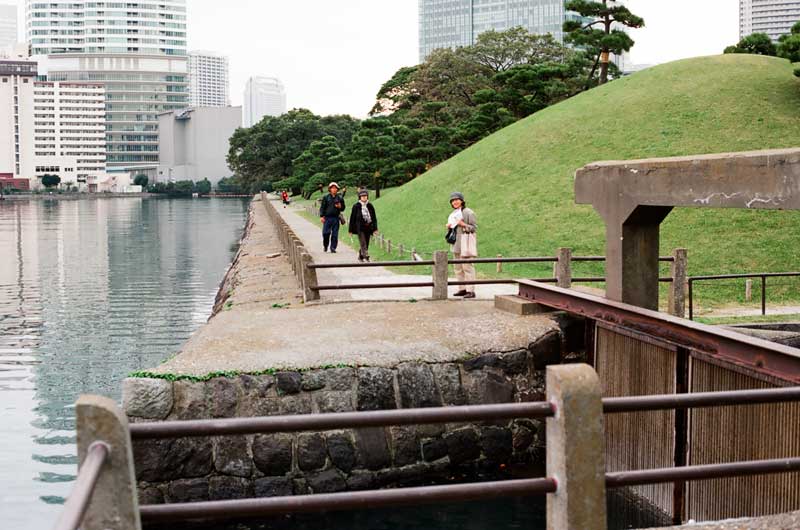

By day, Tokyo’s waterfront is often underwhelming visually: a mix of port shipping, older buildings that routinely turned their backs to what used to be polluted water, and new luxury high rises. By night, the water sparkles, and the city is far more seductive.
I love how this flood gate on the Shibaura canal has a giant cartoon fish. When the gate is lowered, the painted fish descends to join the real fish in the canal. I wonder why his heading is facing up. Maybe he doesn’t want to leave the city’s bright lights just yet.

This wide stretch of water, between the Tokyo Bay and the Sunamachi canal, was originally used in Edo times as a timber dock. Now it includes a bridge for trains and features fish that spend the summer jumping out of the water. In the distance, you can see Sky Tree. View from Tatsumi International Swimming Center.

三度目に芝浦に行ったとき、きれいな水に近づける運河を見つけました。道路と水の間を歩けます。地下に、小さな古い運河の出口も見つけました。
On my third trip to Shibaura, I discovered that there is one canal that provides wonderful, up-close access to water. It’s the first canal when entering from the JR Yamanote station. There’s even paths below the bridges and just above the water. On a drizzly afternoon, it was magical to be below the roadway.
Most of Tokyo’s rivers are buried, and the few remaining ones, including much of the Kanda and Zenpukuji rivers, are channeled 10 meters below street level to manage flooding. Sometimes I hear ducks echoing in these canyons, but the distance between people and water is a missed opportunity.
At the Shibaura canal, I found a tiny canal opening that seems to do pre-date the more recent developments. I like the old stones at the entrance. All that’s missing from this canal is space to get your feet wet, or even go in for a swim.


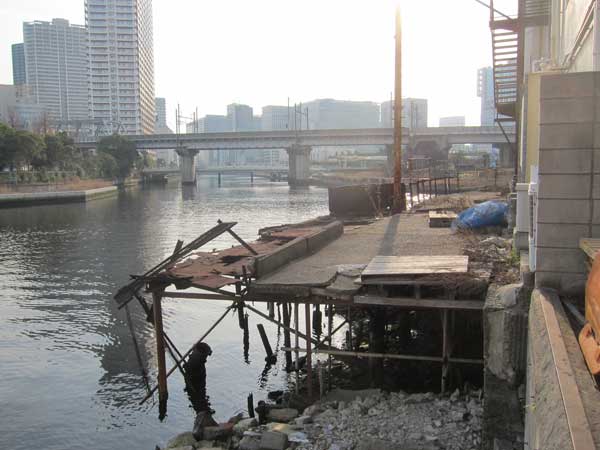
We snuck behind some buildings to gain furtive access to the canal. It’s too bad that Shibaura’s many canals cannot be easily accessed. Once by the water, we saw decayed structures and ample garbage.


最近、芝浦の辺りをオーストラリア人の建築家・ランドスケープアーチストと散歩しました。芝浦ハウスという新しくてかっこいい文化のスペースは、一度行ったことかあります。今回は、色々な運河に区切られた人工島を観察できました。一番驚いたことは、水道局庁舎が5件もあることです。地図から、たくさんの水道局関係の言葉を勉強しました。排水機場、下水、汚泥、処理、庁舎、水再生、ポンプ所。芝浦は東京都の下水道と雨水の処理に不可欠だそうです。
Last month Australia’s smlwrld‘s Bianca and Lucas invited me to go with them on a walking adventure in Shibaura. They took some great photos and wrote up a post calling Shibaura “an infrastructure theme park.”
I’d only been once before, drawn to see the new cultural space Shibaura House. This second time, in addition to stopping back at Shibaura House, we explored the neighborhood and were stunned by the mix of uses being made of these small man-made islands criss-crossed with canals.
There are many water works facilities, a giant incinerator, docks for shipping and at least one re-purposed warehouse named Tabloid, offices from the 70s and 80s, newer apartment towers, industrial buildings, a cement factory, elevated monorail, and the base of the Rainbow Bridge. The top photo shows party boats and a fishing boat, alongside offices and residences.
The water works facilities include sludge, sewage, treatment, and pumping. It seems like most of Tokyo’s plumbing ends up being processed and then released into Tokyo Bay in Shibaura. It’s something to think of when using a sink or toilet, or imagining what happens to the sewers during a heavy rainstorm. Below is a map showing five water work facilities.
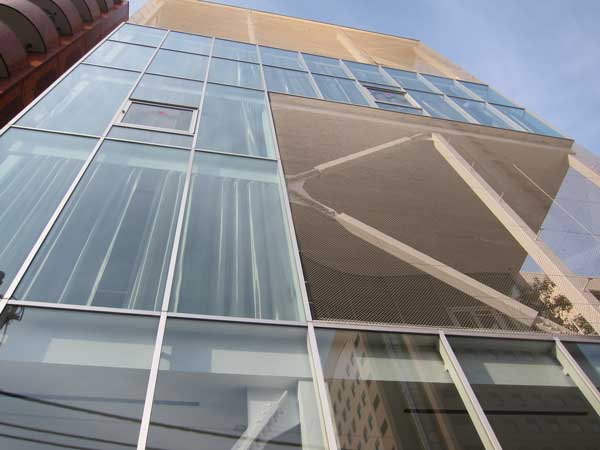
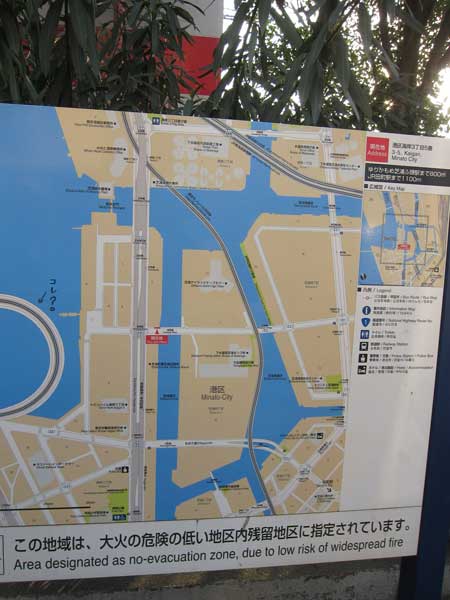
I like how on this very official map, someone has written “これ?” (here?) with an arrow pointing to the giant round entrance ramp to Rainbow Bridge. I’ll post more photos in the coming days from this walk.

友だちに会うために、最近に辰巳に行きました。運河がきれいで、新しいマンションが建設されています。しかし、公共のインフラは不全なままです。改良して、水辺に近づけるほうがいいと思います。東京湾をもっと感じたいです。
I recently visited Tatsumi, a landfill island near Yumenoshima in in Koto-ku for a house party. There are lot of new housing developments alongside the canals and neighboring old housing complexes. It’s sad that the public infrastructure is so incomplete. This neighborhood would be much more appealing if the canal-side sidewalks and parks were continuous. This lack of access to the Bay makes me often forget that there is a Tokyo waterfront.
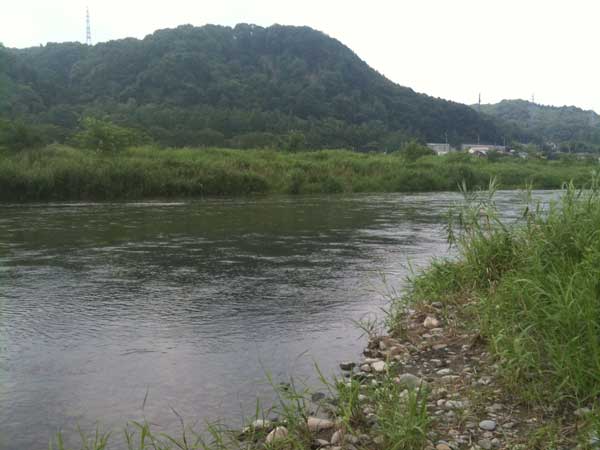
It was a great treat to get a bike tour of the Tama river from Akishima to Fussa with Chris from @a_small_lab. The wildness of this wide river in summer was refreshing, and I was surprised to see the rolling hills on the other side. We cooled off in this quiet stretch of water.
Chris showed me the origin of the Tamagawa josui, a historic canal that brought fresh water to Edo since the mid 1600s. It’s hard to believe this mix of wilderness, industrial decay, outdoor municipal swimming pools, river fishing, and residential life is also part of Tokyo.


何世紀にもわたって、東京湾や運河が変わった。
These NHK images show how, over the past several centuries, Tokyo filled in the bay, built canals, and later, in the last satellite image, filled in the canals. (Via Mutant Frog Travelogue).

木が人間の環境をもっと魅力的にしているのでしょうか。それとも、人間の環境が木をもっと魅力的にしているのでしょうか。
Do trees make the human environment more attractive, or do human environments make trees more attractive?
On an elevated pedestrian bridge just outside Iidabashi station, on the way to Koishikawa Korakuen, this gorgeous street tree and its fiery leaves caught my attention. It stands in front of two intersecting wide boulevards, two elevated freeways, and two shadowed canals. Not only does the tree soften the urban blight of devoting so much space to cars and their air pollution. I think the mundane and gruesome human environment also elevate the tree’s beauty beyond what it might attain in more pristine wildness.
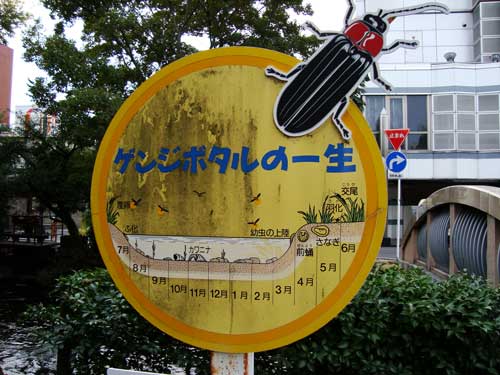
During an October visit to Okayama, a friend stumbled upon an amazing firefly habitat in Nishigawa park, a small canal with a lovely walking path cutting through the center of the city. Although now hatching below water, as the sign above shows, it was amazing to see how a city creats an urban habitat for fireflies. And it reminds me of Professor Suzuki Makoto’s firefly project in Shinagawa, Tokyo.

The firefly habitat occupies one long block of the Nishigawa park, which has different walkways, seating areas and plant arrangements on each block. For fireflies, there is a small slow-flowing, side canal where the fireflies hatch on the opposite side of the wood bridge from the main canal. A huge wall of vegetation provides nocturnal darkness and protection.

I am curious how long the park has been around, and what it is like during summer firefly season.
More on Nishigawa park after the jump.